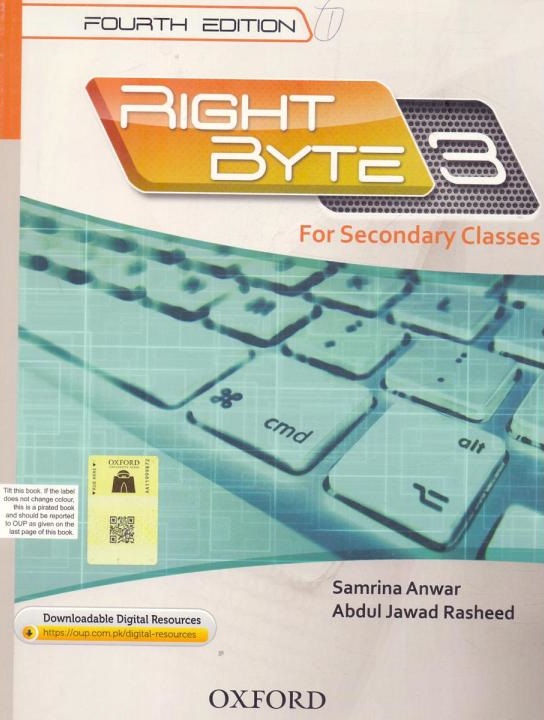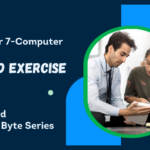Data Production and Security
8th Class Chapter 8 -Computer of the Oxford Right Byte Series for 8th class computer studies dives into advanced computing concepts, making them accessible and relatable for students. For students studying in bilingual or Urdu-medium settings, translating these topics from English to Urdu can greatly enhance comprehension.
This blog provides an English-to-Urdu translation of the key concepts from Chapter 8, enabling students to grasp the material effectively and support teachers in bilingual classrooms.
Overview of Oxford Right Byte Series
The Oxford Right Byte Series is a widely recognized textbook series for teaching computer studies in schools. For 8th Class Chapter 8 – Computer students, Chapter 8 in this series focuses on important concepts related to computers, equipping students with essential knowledge in the digital world.
If you’re studying for exams or need help with your assignments, this post will walk you through the translation English to Urdu for 8th Class Chapter 8 – Computer, providing you with clear and concise answers to strengthen your understanding.
Chapter Outline for 8th Class Chapter 8 – Computer (English to Urdu)
- What is data protection and security?
- Common security issues
- Forms of security threats
- Sources of security threats
- Common modes of security threats
- Antivirus software

In the previous chapter we learned about data integrity. Data that is complete, accurate, and sensible produces reliable results. We use data verification and validation techniques to ensure the integrity of data. After we acquire data, we also need to protect it from being destroyed. Data might also fall into the wrong hands and be misused. We also need to secure our data so that only the right people can access and use it. In this chapter we will learn how we can protect our data and secure it against intruders.
پچھلے باب میں ہم نے ڈیٹا کی سالمیت کے بارے میں سیکھا۔ مکمل، درست اور سمجھ دار ڈیٹا قابل اعتماد نتائج پیدا کرتا ہے۔ ہم ڈیٹا کی سالمیت کو یقینی بنانے کے لیے ڈیٹا کی تصدیق اور توثیق کی تکنیک استعمال کرتے ہیں۔ ڈیٹا حاصل کرنے کے بعد، ہمیں اسے تباہ ہونے سے بچانے کی بھی ضرورت ہے۔ ڈیٹا غلط ہاتھوں میں بھی جا سکتا ہے اور غلط استعمال ہو سکتا ہے۔ ہمیں اپنے ڈیٹا کو محفوظ کرنے کی بھی ضرورت ہے تاکہ صرف صحیح لوگ ہی اس تک رسائی اور استعمال کر سکیں۔ اس باب میں ہم سیکھیں گے کہ ہم اپنے ڈیٹا کی حفاظت کیسے کر سکتے ہیں اور اسے گھسنے والوں کے خلاف محفوظ کر سکتے ہیں۔
What is data protection and security?
Information security is the primary concern of the IT world.
Being connected to the Internet involves sharing a lot of information. We enter our user id and password to access our email account. We talk about our personal interests, daily activities, likes, and dislikes when interacting with online friends.
We disclose our address, bank account number, and credit card number when we shop online. All of this information is very personal. It should not be known to any unconcerned person.
Both businesses and users suffer because of poor information security. Your personal data might reveal things that you would not like to disclose to the general public. This information can be stolen from a business’s database. This data can be used to harass people, commit fraud, and engage in other criminal activities. When this happens, fewer people use the Internet. This results in a loss for online businesses. Therefore, it becomes important for them to protect their customers’ data from being stolen or misused.
More Useful Links for your Study!
Let’s learn about the ways in which data can be misused.
معلومات کی حفاظت آئی ٹی کی دنیا کی بنیادی تشویش ہے۔
انٹرنیٹ سے منسلک ہونے میں بہت ساری معلومات کا اشتراک شامل ہے۔ ہم اپنے ای میل اکاؤنٹ تک رسائی کے لیے اپنا یوزر آئی ڈی اور پاس ورڈ درج کرتے ہیں۔ آن لائن دوستوں کے ساتھ بات چیت کرتے وقت ہم اپنی ذاتی دلچسپیوں، روزمرہ کی سرگرمیوں، پسند اور ناپسند کے بارے میں بات کرتے ہیں۔ جب ہم آن لائن خریداری کرتے ہیں تو ہم اپنا پتہ، بینک اکاؤنٹ نمبر، اور کریڈٹ کارڈ نمبر ظاہر کرتے ہیں۔ یہ تمام معلومات بہت ذاتی ہیں۔ اس کا علم کسی بے پرواہ شخص کو نہیں ہونا چاہیے۔
معلومات کی ناقص حفاظت کی وجہ سے کاروبار اور صارفین دونوں کو نقصان ہوتا ہے۔ آپ کا ذاتی ڈیٹا ایسی چیزوں کو ظاہر کر سکتا ہے جو آپ عام لوگوں کے سامنے ظاہر نہیں کرنا چاہیں گے۔ یہ معلومات کاروبار کے ڈیٹا بیس سے چوری کی جا سکتی ہیں۔ یہ ڈیٹا لوگوں کو ہراساں کرنے، فراڈ کرنے اور دیگر مجرمانہ سرگرمیوں میں ملوث ہونے کے لیے استعمال کیا جا سکتا ہے۔ جب ایسا ہوتا ہے تو بہت کم لوگ انٹرنیٹ استعمال کرتے ہیں۔ اس کے نتیجے میں آن لائن کاروبار کو نقصان ہوتا ہے۔ اس لیے ان کے لیے یہ ضروری ہو جاتا ہے کہ وہ اپنے صارفین کا ڈیٹا چوری یا غلط استعمال ہونے سے بچائیں۔
آئیے ان طریقوں کے بارے میں جانتے ہیں جن میں ڈیٹا کا غلط استعمال کیا جا سکتا ہے۔
Common security issues
As people have started sharing more and more information on the Internet, the problems of data security have also grown. Some of these are man-made, like Internet fraud and viruses, while others are the result of natural disasters, such as floods, fires, earthquakes, and so on.
جیسے جیسے لوگوں نے انٹرنیٹ پر زیادہ سے زیادہ معلومات کا اشتراک کرنا شروع کیا ہے، ڈیٹا کی حفاظت کے مسائل بھی بڑھ گئے ہیں۔ ان میں سے کچھ انسانوں کے بنائے ہوئے ہیں، جیسے انٹرنیٹ فراڈ اور وائرس، جبکہ دیگر قدرتی آفات، جیسے سیلاب، آگ، زلزلے وغیرہ کا نتیجہ ہیں۔
Both these types of threats can result in loss or theft of data. Let’s discuss man-made threats in more detail.
ان دونوں قسم کے خطرات کے نتیجے میں ڈیٹا کے نقصان یا چوری ہو سکتے ہیں۔ آئیے مزید تفصیل سے انسان ساختہ خطرات پر بات کرتے ہیں۔
Data privacy
We feel comfortable when sharing some information with strangers. We do not mind telling people our name or our views on general things like the weather. But some information is private: we do not like to disclose it to people we do not know personally. Our address, telephone number, password, and bank account number are data that we like to keep private. When we have to disclose it to others, such as a bank manager or a shopkeeper, we expect them to keep such data to themselves and disclose it to relevant people only. This is called data privacy.
اجنبیوں کے ساتھ کچھ معلومات کا اشتراک کرتے وقت ہم آرام دہ محسوس کرتے ہیں۔ ہمیں لوگوں کو اپنا نام بتانے یا موسم جیسی عام چیزوں پر اپنے خیالات بتانے میں کوئی اعتراض نہیں ہے۔ لیکن کچھ معلومات نجی ہوتی ہیں: ہم اسے ان لوگوں کے سامنے ظاہر کرنا پسند نہیں کرتے جنہیں ہم ذاتی طور پر نہیں جانتے۔ ہمارا پتہ، ٹیلی فون نمبر، پاس ورڈ، اور بینک اکاؤنٹ نمبر وہ ڈیٹا ہے جسے ہم نجی رکھنا چاہتے ہیں۔ جب ہمیں اسے دوسروں کے سامنے ظاہر کرنا ہوتا ہے، جیسے کہ بینک مینیجر یا دکاندار، تو ہم ان سے توقع کرتے ہیں کہ وہ اس طرح کا ڈیٹا اپنے پاس رکھیں اور اسے صرف متعلقہ لوگوں کے سامنے ظاہر کریں۔ اسے ڈیٹا پرائیویسی کہتے ہیں۔
Data privacy involves protecting information and allowing access to relevant people only Customers should trust businesses to secure their data. Businesses need to judge who should have access to customer data and who should not. Since information is a highly sensitive password secret or asking you a secret question. We learned about these techniques and checks and controls are placed on who can access it. Businesses do this by keeping your password secret or asking you a secret question. We learned about these techniques in Book 2.
ڈیٹا پرائیویسی میں معلومات کی حفاظت اور صرف متعلقہ لوگوں تک رسائی کی اجازت دینا شامل ہے صارفین کو اپنے ڈیٹا کو محفوظ بنانے کے لیے کاروبار پر بھروسہ کرنا چاہیے۔ کاروباری اداروں کو یہ فیصلہ کرنے کی ضرورت ہے کہ کس کو کسٹمر کے ڈیٹا تک رسائی حاصل ہونی چاہیے اور کس کو نہیں۔ چونکہ معلومات ایک انتہائی حساس پاس ورڈ راز ہے یا آپ سے کوئی خفیہ سوال پوچھ رہی ہے۔ ہم نے ان تکنیکوں کے بارے میں سیکھا اور اس بات پر چیک اور کنٹرول رکھے گئے ہیں کہ کون اس تک رسائی حاصل کر سکتا ہے۔ کاروبار آپ کے پاس ورڈ کو خفیہ رکھ کر یا آپ سے کوئی خفیہ سوال پوچھ کر ایسا کرتے ہیں۔ ہم نے کتاب 2 میں ان تکنیکوں کے بارے میں سیکھا۔
Identity theft
Identity theft is very common. It happens when one person steals another’s personal information from a computer and uses it for illegal activities. The thief might gain access to a person’s password, personal data, credit card information, hobbies, interests, and so on. In this way, when the police try to trace the criminal, they end up arresting the person whose identity was stolen instead of the real criminal.
Employees who are fired from their jobs might steal the personal data of their customers and sell it to a third party who might misuse it. They do this as a form of revenge against the company that fired them. Some thieves might also use this information to purchase items and then charge them to the original person’s credit card without his knowledge.
شناخت کی چوری بہت عام ہے۔ ایسا اس وقت ہوتا ہے جب ایک شخص کمپیوٹر سے دوسرے کی ذاتی معلومات چرا کر اسے غیر قانونی سرگرمیوں کے لیے استعمال کرتا ہے۔ چور کسی شخص کے پاس ورڈ، ذاتی ڈیٹا، کریڈٹ کارڈ کی معلومات، مشاغل، دلچسپیاں وغیرہ تک رسائی حاصل کر سکتا ہے۔ اس طرح جب پولیس مجرم کا سراغ لگانے کی کوشش کرتی ہے تو وہ اصل مجرم کی بجائے اس شخص کو گرفتار کر لیتی ہے جس کی شناخت چرائی گئی تھی۔
Data integrity
Recall the three attributes of data integrity. Data has to be complete, accurate, and sensible to have integrity. Sometimes, unauthorized people can gain access to data and change it so that it loses its integrity. They might delete some information or add incorrect information. This happens very commonly on websites. Therefore, it is important to protect information from any unauthorized changes. There are various checks and controls that can be applied to protect the integrity of data.
ڈیٹا کی سالمیت کی تین خصوصیات کو یاد کریں۔ درستگی کے لیے ڈیٹا کو مکمل، درست اور سمجھدار ہونا چاہیے۔ بعض اوقات، غیر مجاز لوگ ڈیٹا تک رسائی حاصل کر سکتے ہیں اور اسے تبدیل کر سکتے ہیں تاکہ یہ اپنی سالمیت کھو دیتا ہے۔ وہ کچھ معلومات کو حذف کر سکتے ہیں یا غلط معلومات شامل کر سکتے ہیں۔ یہ ویب سائٹس پر بہت عام ہوتا ہے۔ لہذا، معلومات کو کسی بھی غیر مجاز تبدیلیوں سے محفوظ رکھنا ضروری ہے۔ ڈیٹا کی سالمیت کے تحفظ کے لیے مختلف چیک اور کنٹرولز کا اطلاق کیا جا سکتا ہے۔

Forms of security threats
Threats to data privacy, identity, and data integrity can take several forms. Knowing about these different forms helps us to become aware of them and avoid them. We will look at some common forms of security threats.
ڈیٹا کی رازداری، شناخت، اور ڈیٹا کی سالمیت کو لاحق خطرات کئی شکلیں لے سکتے ہیں۔ ان مختلف شکلوں کے بارے میں جاننا ہمیں ان سے آگاہ ہونے اور ان سے بچنے میں مدد کرتا ہے۔ ہم سیکورٹی کے خطرات کی کچھ عام شکلوں کو دیکھیں گے۔
Internet fraud
Fraud happens when a person cheats another for some financial gain. Fraud is quite common in business. We hear about incidents of fraud all the time. Now that many businesses have become Internet-based, we also find fraud taking place over the Internet.
فراڈ تب ہوتا ہے جب کوئی شخص کسی مالی فائدے کے لیے دوسرے کو دھوکہ دیتا ہے۔ کاروبار میں دھوکہ دہی کافی عام ہے۔ ہم ہر وقت دھوکہ دہی کے واقعات کے بارے میں سنتے ہیں۔ اب چونکہ بہت سے کاروبار انٹرنیٹ پر مبنی ہو چکے ہیں، ہمیں انٹرنیٹ پر دھوکہ دہی بھی ہوتی نظر آتی ہے۔
Unfortunately, Internet fraud is very easy because buyers and sellers cannot see each other or meet personally. They might be located at very large distances from each other. Internet fraud can take the form of scams. A scam is committed when a person promises to give out huge prizes to people who provide their personal details on a website or through email. However, after providing personal data, they receive nothing. The fraudster disappears with all their personal information and cannot be caught. He might then use that information to commit crimes. Serious Internet frauds involve asking online customers to make an online purchase. The fraudster then disappears with the money without delivering the goods.
بدقسمتی سے، انٹرنیٹ فراڈ بہت آسان ہے کیونکہ خریدار اور بیچنے والے ایک دوسرے کو نہیں دیکھ سکتے اور نہ ہی ذاتی طور پر مل سکتے ہیں۔ وہ ایک دوسرے سے بہت زیادہ فاصلے پر واقع ہوسکتے ہیں۔ انٹرنیٹ فراڈ گھوٹالوں کی شکل اختیار کر سکتا ہے۔ اسکام اس وقت ہوتا ہے جب کوئی شخص ان لوگوں کو بھاری انعامات دینے کا وعدہ کرتا ہے جو اپنی ذاتی تفصیلات ویب سائٹ یا ای میل کے ذریعے فراہم کرتے ہیں۔ تاہم، ذاتی ڈیٹا فراہم کرنے کے بعد، انہیں کچھ نہیں ملتا. دھوکہ باز اپنی تمام ذاتی معلومات کے ساتھ غائب ہو جاتا ہے اور اسے پکڑا نہیں جا سکتا۔ اس کے بعد وہ اس معلومات کو جرم کرنے کے لیے استعمال کر سکتا ہے۔ انٹرنیٹ کے سنگین دھوکہ دہی میں آن لائن صارفین سے آن لائن خریداری کے لیے کہنا شامل ہے۔ دھوکہ باز پھر سامان کی ڈیلیوری کیے بغیر رقم لے کر غائب ہو جاتا ہے۔
Hacking
Hackers are people who gain access to a computer and then carry out activities like stealing data, changing information, and so on. These activities are done without the knowledge of the original user. Hackers usually target e-commerce websites and online banking websites. A hacker might hack a system to steal money and information, or just for fun.
ہیکرز وہ لوگ ہوتے ہیں جو کمپیوٹر تک رسائی حاصل کرتے ہیں اور پھر ڈیٹا چوری کرنا، معلومات تبدیل کرنا وغیرہ جیسی سرگرمیاں انجام دیتے ہیں۔ یہ سرگرمیاں اصل صارف کے علم کے بغیر کی جاتی ہیں۔ ہیکرز عام طور پر ای کامرس ویب سائٹس اور آن لائن بینکنگ ویب سائٹس کو نشانہ بناتے ہیں۔ ایک ہیکر پیسہ اور معلومات چوری کرنے یا محض تفریح کے لیے سسٹم کو ہیک کر سکتا ہے۔
Phishing
Phishing (pronounced fishing) is an illegal activity. It happens when someone pretends to be a reliable organization, such as a bank, to obtain personal information. The phisher creates a website that is similar to the website of an actual bank. The phisher then sends email messages to the customers of the actual bank asking them to visit the phisher’s website. This misleads Internet users and they disclose private information such as their bank account number on the phisher’s website. The phisher can then misuse this information.
فشنگ (تلفظی ماہی گیری) ایک غیر قانونی سرگرمی ہے۔ ایسا تب ہوتا ہے جب کوئی شخص ذاتی معلومات حاصل کرنے کے لیے ایک قابل اعتماد تنظیم، جیسے کہ بینک، ہونے کا بہانہ کرتا ہے۔ فشر ایک ایسی ویب سائٹ بناتا ہے جو ایک حقیقی بینک کی ویب سائٹ سے ملتی جلتی ہے۔ اس کے بعد فشر حقیقی بینک کے صارفین کو ای میل پیغامات بھیجتا ہے اور ان سے فشر کی ویب سائٹ پر جانے کے لیے کہتا ہے۔ یہ انٹرنیٹ صارفین کو گمراہ کرتا ہے اور وہ فشر کی ویب سائٹ پر نجی معلومات جیسے کہ اپنا بینک اکاؤنٹ نمبر ظاہر کرتے ہیں۔ پھر فشر اس معلومات کا غلط استعمال کر سکتا ہے۔
Adware and spyware
Adware is a type of software that is annoying but usually harmless. When a user visits a website, adware displays advertisements on the computer screen. These advertisements appear in pop-up windows. This can be very irritating for the user because he has to close a pop-up window each time it appears.
ایڈویئر سافٹ ویئر کی ایک قسم ہے جو پریشان کن ہے لیکن عام طور پر بے ضرر ہے۔ جب کوئی صارف کسی ویب سائٹ پر جاتا ہے تو ایڈویئر کمپیوٹر اسکرین پر اشتہارات دکھاتا ہے۔ یہ اشتہارات پاپ اپ ونڈوز میں ظاہر ہوتے ہیں۔ یہ صارف کے لیے بہت پریشان کن ہو سکتا ہے کیونکہ اسے ہر بار پاپ اپ ونڈو کو بند کرنا پڑتا ہے۔
Sometimes adware runs with another type of software called spyware. Spyware monitors the websites the user visits. It sends this information to a pre-defined source. That source can then misuse the information or sell it to interested parties, such as owners of other websites. The owners use this information to make their websites more interesting because they know what type of websites different users usually visit.
بعض اوقات ایڈویئر ایک اور قسم کے سافٹ ویئر کے ساتھ چلتا ہے جسے اسپائی ویئر کہتے ہیں۔ اسپائی ویئر ان ویب سائٹس کی نگرانی کرتا ہے جو صارف دیکھتا ہے۔ یہ یہ معلومات پہلے سے طے شدہ ذریعہ کو بھیجتا ہے۔ اس کے بعد وہ ذریعہ معلومات کا غلط استعمال کر سکتا ہے یا اسے دلچسپی رکھنے والی جماعتوں، جیسے کہ دوسری ویب سائٹس کے مالکان کو فروخت کر سکتا ہے۔ مالکان اس معلومات کو اپنی ویب سائٹس کو مزید دلچسپ بنانے کے لیے استعمال کرتے ہیں کیونکہ وہ جانتے ہیں کہ مختلف صارفین عام طور پر کس قسم کی ویب سائٹس دیکھتے ہیں۔

Sources of security threats
We have identified some common forms of security threats. We can protect our data from such threats if we know where these threats come from. We will learn about some sources of security threats in this section.
ہم نے حفاظتی خطرات کی کچھ عام شکلوں کی نشاندہی کی ہے۔ ہم اپنے ڈیٹا کو ایسے خطرات سے محفوظ رکھ سکتے ہیں اگر ہمیں معلوم ہو کہ یہ خطرات کہاں سے آتے ہیں۔ ہم اس سیکشن میں سیکیورٹی خطرات کے کچھ ذرائع کے بارے میں جانیں گے۔
Computer viruses
Computer viruses are one of the biggest threats to data security. A computer virus is a dangerous program. It can travel with a data file, such as a Word document or a spreadsheet. Whenever the data file travels across a network, the virus travels with it. The data file is called a carrier file. When a user downloads a carrier file onto his computer, the virus infects the computer. The virus then replicates (produces more viruses like itself). These viruses then destroy all the data stored on the computer.
کمپیوٹر وائرس ڈیٹا کی حفاظت کے لیے سب سے بڑے خطرات میں سے ایک ہیں۔ کمپیوٹر وائرس ایک خطرناک پروگرام ہے۔ یہ ڈیٹا فائل کے ساتھ سفر کر سکتا ہے، جیسے کہ ورڈ دستاویز یا اسپریڈشیٹ۔ جب بھی ڈیٹا فائل کسی نیٹ ورک پر سفر کرتی ہے، وائرس اس کے ساتھ سفر کرتا ہے۔ ڈیٹا فائل کو کیریئر فائل کہا جاتا ہے۔ جب کوئی صارف اپنے کمپیوٹر پر کیریئر فائل ڈاؤن لوڈ کرتا ہے، تو وائرس کمپیوٹر کو متاثر کرتا ہے۔ وائرس پھر نقل کرتا ہے (اپنے جیسے مزید وائرس پیدا کرتا ہے)۔ اس کے بعد یہ وائرس کمپیوٹر میں محفوظ تمام ڈیٹا کو تباہ کر دیتے ہیں۔
Viruses can spread very fast. A single virus can affect thousands of computers at the same time. Apart from a computer network, viruses can also spread through infected CDs and USB drives. A virus infects a CD or USB drive when they are used in an infected computer.
وائرس بہت تیزی سے پھیل سکتے ہیں۔ ایک وائرس ایک ہی وقت میں ہزاروں کمپیوٹرز کو متاثر کر سکتا ہے۔ کمپیوٹر نیٹ ورک کے علاوہ، وائرس متاثرہ سی ڈیز اور یو ایس بی ڈرائیوز کے ذریعے بھی پھیل سکتے ہیں۔ ایک وائرس CD یا USB ڈرائیو کو متاثر کرتا ہے جب وہ کسی متاثرہ کمپیوٹر میں استعمال ہوتے ہیں۔
Trojan horses
A Trojan horse is a harmful program that appears to be useful. It was first developed to control computer networks from a distance. However, it is now commonly used to steal private information such as passwords from a computer. Hackers use Trojan horses to hack computer systems.
A Trojan horse can also delete files from the computer, waste the memory of the computer, and force the computer to crash. It can also allow a hacker to view the user’s computer screen. In this way, the hacker can keep a watch on what the user is doing on the computer.
ٹروجن ہارس ایک نقصان دہ پروگرام ہے جو مفید معلوم ہوتا ہے۔ اسے پہلے کمپیوٹر نیٹ ورکس کو دور سے کنٹرول کرنے کے لیے تیار کیا گیا تھا۔ تاہم، اب یہ عام طور پر کمپیوٹر سے پاس ورڈ جیسی نجی معلومات چرانے کے لیے استعمال ہوتا ہے۔ ہیکرز ہیک کرنے کے لیے ٹروجن ہارسز کا استعمال کرتے ہیں۔
کمپیوٹر سسٹمز
ٹروجن ہارس کمپیوٹر سے فائلیں بھی ڈیلیٹ کر سکتا ہے، کمپیوٹر کی میموری کو ضائع کر سکتا ہے اور کمپیوٹر کو کریش ہونے پر مجبور کر سکتا ہے۔ یہ ہیکر کو صارف کی کمپیوٹر اسکرین دیکھنے کی بھی اجازت دے سکتا ہے۔ اس طرح ہیکر اس بات پر نظر رکھ سکتا ہے کہ صارف کمپیوٹر پر کیا کر رہا ہے۔
Worms
Worms normally use computer networks to move to different computers. A key difference between a worm and a virus is that viruses normally attach to files and corrupt them; worms create copies of themselves that are transmitted over computer networks. The Morris worm was one of the first computer worms to be distributed via the Internet.
کیڑے عام طور پر مختلف کمپیوٹرز پر جانے کے لیے کمپیوٹر نیٹ ورکس کا استعمال کرتے ہیں۔ کیڑے اور وائرس کے درمیان ایک اہم فرق یہ ہے کہ وائرس عام طور پر فائلوں سے منسلک ہوتے ہیں اور انہیں خراب کر دیتے ہیں۔ کیڑے خود کی کاپیاں بناتے ہیں جو کمپیوٹر نیٹ ورکس پر منتقل ہوتے ہیں۔ مورس ورم انٹرنیٹ کے ذریعے تقسیم کیے جانے والے پہلے کمپیوٹر کیڑے میں سے ایک تھا۔
Common modes of security threats
Now that we know where threats to data security come from, we should also know how viruses, Trojan horses, and worms might enter our system. This helps us to create barriers that prevent them from infecting our computers. The common modes of security threats are described in this section.
اب جبکہ ہم جانتے ہیں کہ ڈیٹا کی حفاظت کو خطرات کہاں سے آتے ہیں، ہمیں یہ بھی جاننا چاہیے کہ وائرس، ٹروجن ہارسز اور کیڑے ہمارے سسٹم میں کیسے داخل ہو سکتے ہیں۔ اس سے ہمیں ایسی رکاوٹیں پیدا کرنے میں مدد ملتی ہے جو انہیں ہمارے کمپیوٹرز کو متاثر کرنے سے روکتی ہیں۔ سلامتی کے خطرات کے عام طریقوں کو اس حصے میں بیان کیا گیا ہے۔
Infected drives and devices
Viruses can infect any kind of storage medium, such as a hard disk, CD, DVD, or USB drive. Portable storage media are more vulnerable because they are used on different computers, unlike the internal hard disk which is fixed inside a single computer. When a portable storage medium is used in an infected computer, the device gets infected too. When the infected storage medium is then used on an uninfected computer, the computer gets infected. Since viruses destroy data stored on the computer or cause it to malfunction, we should avoid using portable storage devices from unknown sources and should install an antivirus program on our computers to guard against such threats. We will learn about this later in the chapter.
وائرس کسی بھی قسم کے سٹوریج میڈیم جیسے ہارڈ ڈسک، CD، DVD، یا USB ڈرائیو کو متاثر کر سکتے ہیں۔ پورٹ ایبل سٹوریج میڈیا زیادہ کمزور ہوتے ہیں کیونکہ وہ مختلف کمپیوٹرز پر استعمال ہوتے ہیں، اندرونی ہارڈ ڈسک کے برعکس جو ایک کمپیوٹر کے اندر فکس ہوتی ہے۔ جب کسی متاثرہ کمپیوٹر میں پورٹیبل اسٹوریج میڈیم استعمال کیا جاتا ہے، تو آلہ بھی متاثر ہو جاتا ہے۔ جب انفیکٹڈ اسٹوریج میڈیم کو غیر متاثر شدہ کمپیوٹر پر استعمال کیا جاتا ہے تو کمپیوٹر متاثر ہو جاتا ہے۔ چونکہ وائرس کمپیوٹر پر ذخیرہ شدہ ڈیٹا کو تباہ کر دیتے ہیں یا اس میں خرابی کا باعث بنتے ہیں، اس لیے ہمیں نامعلوم ذرائع سے پورٹیبل اسٹوریج ڈیوائسز کے استعمال سے گریز کرنا چاہیے اور ایسے خطرات سے بچنے کے لیے اپنے کمپیوٹرز پر ایک اینٹی وائرس پروگرام انسٹال کرنا چاہیے۔ اس کے بارے میں ہم بعد میں باب میں سیکھیں گے۔
Email attachments
The Internet is a library for global information and also a very tricky place. Some Internet users can circulate email messages that can cause harm to computer systems and result in a loss of data. This happens when innocent users click on email attachments that contain viruses. We can avoid this by only opening email sent by people we know.
انٹرنیٹ عالمی معلومات کے لیے ایک لائبریری ہے اور ایک بہت ہی مشکل جگہ بھی۔ کچھ انٹرنیٹ صارفین ایسے ای میل پیغامات کو گردش کر سکتے ہیں جو کمپیوٹر سسٹم کو نقصان پہنچا سکتے ہیں اور اس کے نتیجے میں ڈیٹا ضائع ہو سکتا ہے۔ ایسا اس وقت ہوتا ہے جب معصوم صارفین وائرس پر مشتمل ای میل اٹیچمنٹ پر کلک کرتے ہیں۔ ہم اس سے بچ سکتے ہیں صرف ان لوگوں کی طرف سے بھیجی گئی ای میل کھول کر جو ہم جانتے ہیں۔
Unsecured websites
Each website offers content that attracts users. These users might also include hackers. They might hack these websites so that any personal data that innocent users provide to the website is redirected to the hackers. Therefore, websites should maintain high security levels and users should think twice before giving away personal information to anyone on the Internet.
ہر ویب سائٹ ایسا مواد پیش کرتی ہے جو صارفین کو اپنی طرف متوجہ کرتی ہے۔ ان صارفین میں ہیکرز بھی شامل ہو سکتے ہیں۔ وہ ان ویب سائٹس کو ہیک کر سکتے ہیں تاکہ کوئی بھی ذاتی ڈیٹا جو معصوم صارفین ویب سائٹ کو فراہم کرتے ہیں وہ ہیکرز کو بھیج دیا جائے۔ لہذا، ویب سائٹس کو اعلیٰ حفاظتی سطح کو برقرار رکھنا چاہیے اور صارفین کو انٹرنیٹ پر کسی کو بھی ذاتی معلومات دینے سے پہلے دو بار سوچنا چاہیے۔
Pirated software
Most software companies require users to pay a certain amount of money as licensing fee before installing and using any software made by the company. If a user obtains that software from some other source and starts using it without paying the licensing fee, it is called software piracy. The software is identified as pirated software.
One can usually obtain pirated software from local computer vendors who make copies of the original software CD or DVD on their own computers. These copies are then sold at very low prices. Most of the time the computers used by such vendors are infected with viruses, which results in the viruses being transferred to the CD or DVD when the software is copied on them. If we use such a CD or DVD on our computer, the viruses would be transferred to our computer.
زیادہ تر سافٹ ویئر کمپنیاں صارفین سے کمپنی کی طرف سے بنائے گئے کسی بھی سافٹ ویئر کو انسٹال کرنے اور استعمال کرنے سے پہلے لائسنسنگ فیس کے طور پر ایک مخصوص رقم ادا کرنے کا مطالبہ کرتی ہیں۔ اگر کوئی صارف وہ سافٹ ویئر کسی اور ذریعہ سے حاصل کرتا ہے اور لائسنسنگ فیس ادا کیے بغیر اسے استعمال کرنا شروع کر دیتا ہے تو اسے سافٹ ویئر پائریسی کہا جاتا ہے۔ سافٹ ویئر کی شناخت پائریٹڈ سافٹ ویئر کے طور پر کی گئی ہے۔
کوئی بھی عام طور پر مقامی کمپیوٹر فروشوں سے پائریٹڈ سافٹ ویئر حاصل کرسکتا ہے جو اپنے کمپیوٹر پر اصل سافٹ ویئر سی ڈی یا ڈی وی ڈی کی کاپیاں بناتے ہیں۔ پھر یہ کاپیاں بہت کم قیمت پر فروخت ہوتی ہیں۔ زیادہ تر وقت ایسے دکانداروں کے زیر استعمال کمپیوٹر وائرس سے متاثر ہوتے ہیں جس کے نتیجے میں جب سافٹ ویئر ان پر کاپی کیا جاتا ہے تو وائرس سی ڈی یا ڈی وی ڈی میں منتقل ہو جاتے ہیں۔ اگر ہم اپنے کمپیوٹر پر ایسی سی ڈی یا ڈی وی ڈی استعمال کریں گے تو وائرس ہمارے کمپیوٹر میں منتقل ہو جائیں گے۔
Antivirus software
Computer viruses are extremely dangerous for the computer and the information stored on it. Antivirus programs have been designed by different companies to prevent viruses from affecting our data. Antivirus software is software that detects computer viruses and makes them ineffective.
کمپیوٹر وائرس کمپیوٹر اور اس میں محفوظ معلومات کے لیے انتہائی خطرناک ہیں۔ وائرس کو ہمارے ڈیٹا کو متاثر کرنے سے روکنے کے لیے مختلف کمپنیوں کے ذریعے اینٹی وائرس پروگرام بنائے گئے ہیں۔ اینٹی وائرس سافٹ ویئر وہ سافٹ ویئر ہے جو کمپیوٹر وائرس کا پتہ لگاتا ہے اور انہیں غیر موثر بنا دیتا ہے۔
To make a virus ineffective, the antivirus software has to identify what type of virus it is. Remember that a virus is a program that has been written in some programming language. When this program is represented in machine code (consisting of 1s and Os), it is called a virus definition. Antivirus software contains a store of several virus definitions stored in its database. An antivirus program can only control a virus if the virus definition is stored in its database.
کسی وائرس کو غیر موثر بنانے کے لیے، اینٹی وائرس سافٹ ویئر کو یہ شناخت کرنا پڑتا ہے کہ یہ کس قسم کا وائرس ہے۔ یاد رکھیں کہ وائرس ایک پروگرام ہے جو کسی پروگرامنگ زبان میں لکھا گیا ہے۔ جب اس پروگرام کو مشین کوڈ (1s اور Os پر مشتمل) میں دکھایا جاتا ہے، تو اسے وائرس کی تعریف کہا جاتا ہے۔ اینٹی وائرس سافٹ ویئر اپنے ڈیٹا بیس میں ذخیرہ شدہ وائرس کی متعدد تعریفوں کا ذخیرہ رکھتا ہے۔ ایک اینٹی وائرس پروگرام کسی وائرس کو صرف اس صورت میں کنٹرول کر سکتا ہے جب وائرس کی تعریف اس کے ڈیٹا بیس میں محفوظ ہو۔
We should keep in mind that new viruses are being created all the time. It is impossible for a single antivirus software to have every possible virus definition in its database. Therefore,it is important for its database to be updated by adding new virus definitions to the existing ones.
ہمیں یہ بات ذہن میں رکھنی چاہیے کہ ہر وقت نئے وائرس پیدا ہوتے رہتے ہیں۔ کسی ایک اینٹی وائرس سافٹ ویئر کے لیے اپنے ڈیٹا بیس میں وائرس کی ہر ممکنہ تعریف کا ہونا ناممکن ہے۔ اس لیے اس کے ڈیٹا بیس کے لیے یہ ضروری ہے کہ موجودہ میں وائرس کی نئی تعریفیں شامل کر کے اسے اپ ڈیٹ کیا جائے۔
After identifying a virus, the antivirus software controls it in one of three possible ways. First, it tries to remove the virus from the carrier file. This is called disinfecting the file. If it fails to do so, the antivirus software tries to separate, or quarantine, the infected file from other files stored on the computer. This prevents the other files from being infected by the virus. If neither of these works, the antivirus software then deletes the infected file.
وائرس کی شناخت کے بعد، اینٹی وائرس سافٹ ویئر اسے تین ممکنہ طریقوں میں سے ایک طریقے سے کنٹرول کرتا ہے۔ سب سے پہلے، یہ کیریئر فائل سے وائرس کو ہٹانے کی کوشش کرتا ہے۔ اسے فائل کو ڈس انفیکٹ کرنا کہتے ہیں۔ اگر یہ ایسا کرنے میں ناکام ہو جاتا ہے، تو اینٹی وائرس سافٹ ویئر متاثرہ فائل کو کمپیوٹر پر محفوظ دیگر فائلوں سے الگ کرنے یا قرنطینہ کرنے کی کوشش کرتا ہے۔ یہ دوسری فائلوں کو وائرس سے متاثر ہونے سے روکتا ہے۔ اگر ان میں سے کوئی بھی کام نہیں کرتا ہے، تو اینٹی وائرس سافٹ ویئر متاثرہ فائل کو حذف کر دیتا ہے۔
How to scan a computer for viruses?
We now know about the benefits of antivirus software. Without running proper virus scans, viruses and other harmful programs will not be detected. We must regularly run a complete virus scan of critical areas. Critical areas are very important areas that contain startup programs and other important areas. Scanning these areas does not require scanning the whole computer for viruses. Let’s see how we can scan our computer for viruses with the help of antivirus software.
اب ہم اینٹی وائرس سافٹ ویئر کے فوائد کے بارے میں جانتے ہیں۔ مناسب وائرس اسکین چلائے بغیر، وائرس اور دیگر نقصان دہ پروگراموں کا پتہ نہیں چل سکے گا۔ ہمیں باقاعدگی سے نازک علاقوں کا مکمل وائرس اسکین چلانا چاہیے۔ کریٹیکل ایریاز بہت اہم شعبے ہیں جن میں اسٹارٹ اپ پروگرام اور دیگر اہم شعبے ہوتے ہیں۔ ان علاقوں کو اسکین کرنے کے لیے وائرس کے لیے پورے کمپیوٹر کو اسکین کرنے کی ضرورت نہیں ہے۔ آئیے دیکھتے ہیں کہ اینٹی وائرس سافٹ ویئر کی مدد سے ہم اپنے کمپیوٹر کو وائرس کے لیے کیسے سکین کر سکتے ہیں۔
- Click on the icon of the antivirus software to open the main window.
- Click on the Scan button. This displays the likely areas to be scanned including critical areas and My Computer.
- You may choose to scan the entire system or simply those areas (hard drive, USB drives, etc.) that you think might be affected.
- After selecting the appropriate scan areas, click on the Scan button to begin the scanning
- process.
- Since the scanning process takes some time, you might minimize the window and perform other tasks.
- The antivirus program will prompt you as soon as the process has been completed and then display the results.
- If viruses are discovered, you can disinfect, quarantine, or delete them. However, your first priority should be to disinfect the files.
- Remember to update your antivirus software regularly.
مین ونڈو کو کھولنے کے لیے اینٹی وائرس سافٹ ویئر کے آئیکون پر کلک کریں۔
اسکین بٹن پر کلک کریں۔ یہ ممکنہ علاقوں کو ظاہر کرتا ہے جن میں اہم علاقے اور مائی کمپیوٹر شامل ہیں۔
آپ پورے سسٹم کو اسکین کرنے کا انتخاب کرسکتے ہیں یا صرف ان علاقوں (ہارڈ ڈرائیو، USB ڈرائیوز وغیرہ) کو جو آپ کے خیال میں متاثر ہوسکتے ہیں۔
مناسب اسکین علاقوں کو منتخب کرنے کے بعد، اسکیننگ شروع کرنے کے لیے اسکین بٹن پر کلک کریں۔
عمل چونکہ اسکیننگ کے عمل میں کچھ وقت لگتا ہے، اس لیے آپ ونڈو کو کم سے کم کرسکتے ہیں اور دوسرے کام انجام دے سکتے ہیں۔
عمل مکمل ہوتے ہی اینٹی وائرس پروگرام آپ کو اشارہ کرے گا اور پھر نتائج دکھائے گا۔
اگر وائرس دریافت ہو جاتے ہیں، تو آپ انہیں جراثیم کش، قرنطینہ، یا حذف کر سکتے ہیں۔ تاہم، آپ کی پہلی ترجیح فائلوں کو جراثیم سے پاک کرنا ہے۔
اپنے اینٹی وائرس سافٹ ویئر کو باقاعدگی سے اپ ڈیٹ کرنا یاد رکھیں۔
Benefits of English-to-Urdu Translation
This English-to-Urdu translation makes it easier for Urdu-speaking students to understand advanced computer concepts and practice them confidently for 8th Class Chapter 8 – Computer. It helps bridge language gaps in computer education, promoting equal learning opportunities for students in bilingual settings.

Whether you’re a student or teacher, this translation of 8th Class Chapter 8 – Computer serves as a valuable resource, allowing students to excel in their computer studies with ease and confidence.
Note:
Looking for a comprehensive solution to your computer studies exercises? We’ve got you covered! Our solved exercise, all chapters of MCQs, fill in the blanks, questions and answers, and true and false for 8th Class Chapter 8 – Computer from the Oxford Right Byte Series for students, teachers, schools, and colleges who want to enhance their learning and teaching experience are now available in a convenient PDF format.
Please contact us on WhatsApp +92 333 672 2439






